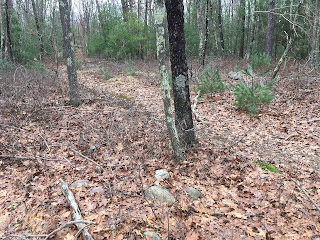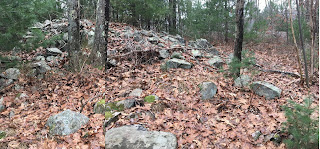New sites were reported from Georgia and South Carolina and, generally, public awareness has continued to expand, both at the state level and the town level. The Native Americans and Doug Harris have been rolling out aggressive outreach campaigns.
-- SITES --
Feb-March:(near) Nod Brook Groton
Howard Brook in Northboro - some fine sites along the brooks of the "Fish and Wildlife" area, south of Mt Pisgah.
"Debunking Stone Wall Myths"
Excellent argument on "crazy" stone walls not being post-colonial
https://www.youtube.com/watch?v=55jQq9M0iiw
April:
South Justice Hill - the best and only large site I found this year.
There were several smaller sites in the valley between the hill and S. Princeton center:
June:
I start exploring to the south, in place like Foxboro and Stoughton:
I explore southern Franklin State Forest:
Still further south at the edge of Wrentham: - mounds (still) have hollows:
October:
I get a little miffed about the spread of fake history:
They seem to all be like this, from Wrentham on south. However, fresher mounds were still to be seen in that area.
December:
Finally, a major site is seen, shown to me by reader "bd" in Wrentham State Forest. It has many varieties of "mound-with-hollow", mostly of the mid-sized sort. From classic:
To multi-chambered:
Also, the kind of "pavement" I am have come to expect in this part of the state:
[or perhaps not? The typical "Wrentham" style is a pile spilling over the edge of a bluff, above a wetland.]
-- SITES OUSIDE NEW ENGLAND --
Cairns and Copper Mines: Drummond Wisconsin. http://rockpiles.blogspot.com/2018/04/outlook-cairn-drummond-wisconsin.html
Chatahoochee National Forest:
Pickens County, SC:
http://rockpiles.blogspot.com/2018/12/from-reader-dg-i-thought-you-might-find.html
Some links:
Finger Lakes area of NY
A Wall Site in Bartow Co., GA
Poconos Rock Piles
Another Stone Complex (GA)
Rock Piles on a Farm in Saskatchewan
Ontario "Megaliths"
Mounds with hollows - headwaters of the Susquehan...
ALEC MOUNTAIN STONE CIRCLE – NACOOCHEE VALLEY
Negwegon Stone Piles - Michigan
-- PUBLIC AWARENESS --
"Let the Landscape Speak:"
Doug Harris's schedule gets filled:































































